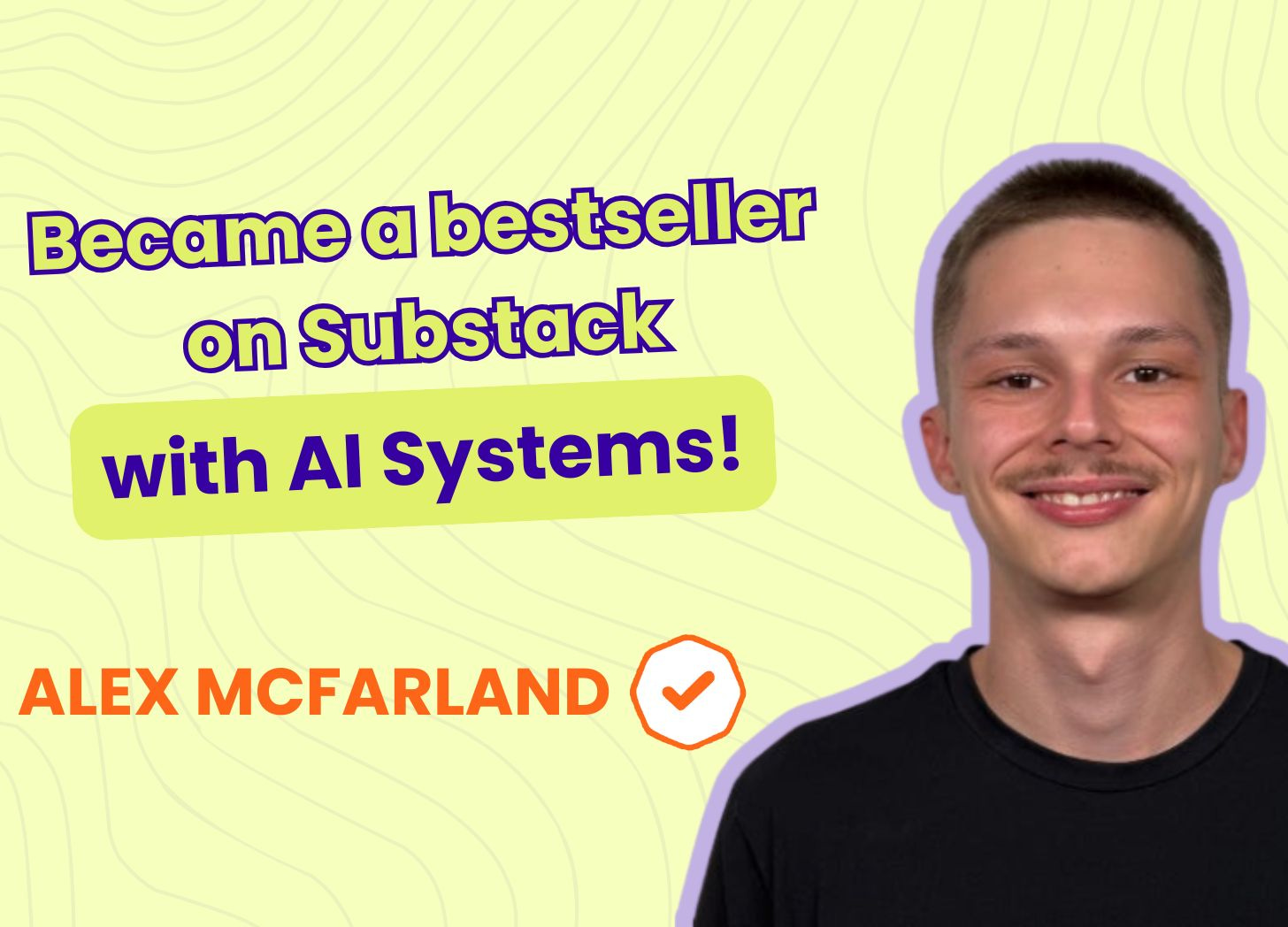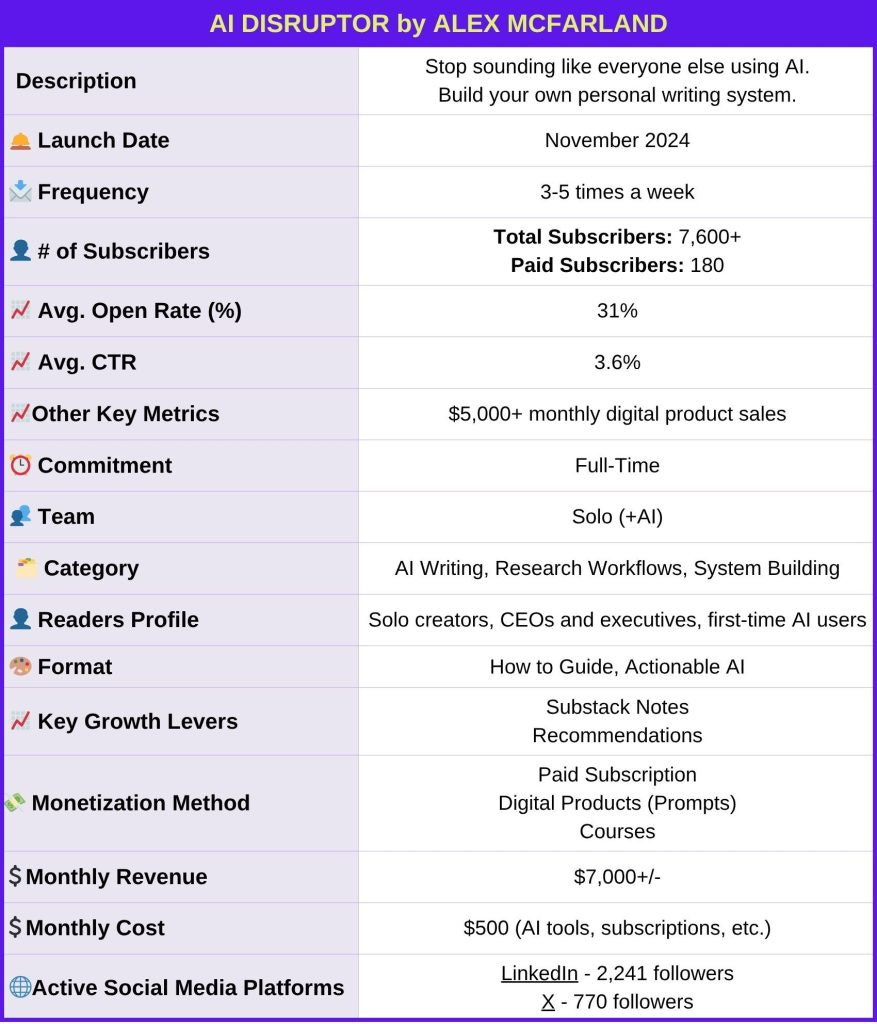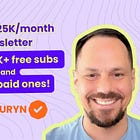Newsletter Circle is your go-to source for building a successful newsletter business through a paid subscription.
UPDATES FROM NEWSLETTER CIRCLE
Your newsletter content is your product.
And similar to all types of other products, you should be clear about your positioning.
In my recent article, I walked you through how and why I respositioned Newsletter Circle (multiple times).
Check out the article if you’re rethinking your niche or struggling to deliver clear value.
I also had the pleasure of talking to from , where we talked about what it really takes to build a newsletter business. Check out our interview here.
👋 MEET THE CREATOR
is not just another voice in the AI space; he’s one of the go-to experts when it comes to applying AI in practical, creator-focused ways.
With a background that spans freelance journalism, ghostwriting for AI founders and CEOs, and running full-scale content operations solo (with the help of AI), he’s spent years building and pressure-testing AI writing systems in fast-moving, high-stakes environments.
He also built his reputation as a regular contributor to major AI publications like Unite AI, where he covered emerging technologies and industry developments. Today, through his Substack newsletter AI Disruptor, Alex teaches creators how to move beyond one-off prompt hacks to build scalable, systemized writing workflows, tools that enhance their voice instead of replacing it.
Within just 7 months, Alex grew AI Disruptor to over 7,000 subscribers, crossed 180 paying members, and built a business fueled by content systems.
In this interview, you’ll learn:
How he used collaboration and consistency to grow fast from 0 to 7,000 readers
His playbook for converting free readers into paying subscribers
The $600+ digital product he sells, and how it fits into his newsletter business
What his personal AI content engine looks like
Why most creators burn out, and how to beat the grind with systems
Enjoy!
🏷 NEWSLETTER IDENTITY CARD
⚒️ TOOL STACK
ESP: Substack
Writing: Claude
Task Management: Notion
Curation & Note taking: ChatGPT, NotebookLM
Productivity: Sunsama
Visual Design: Canva
🥁 START
How and why did you start AI Disruptor in the first place?
I started my career as a freelance writer, eventually finding my way into writing about AI news and developments for various publications. After a few years of covering the industry, I decided to launch my own newsletter—which initially started as a straightforward AI news publication.
But as I was building that newsletter, two things became clear: AI was becoming too important for people not to understand how to use it, and I was simultaneously picking up more work with startups and ghostwriting for AI founders. That's where things got interesting.
Through that client work—working with real companies under real pressure and tight deadlines—I started developing systematic approaches to using AI for writing. Not just prompt tricks, but actual repeatable systems that could think and write in specific voices.
After building these systems for myself and my clients, I realized I could teach other people how to build their own. That's when AI Disruptor really took shape.
Initially, I was creating how-to guides for every new tool that came out. But the AI field exploded so fast that I couldn't keep up with everything. That's when I decided to niche down and focus specifically on what I'd actually proven worked: building personal AI writing systems with established tools rather than chasing every shiny new feature.
🚀 GROWTH
Which strategies did you use to grow over 7,000 subscribers?
0 – 100 Subscribers
Honestly, I can't take much credit for this stage. I already had some audience recognition from my work writing about AI for various news publications. Building a name in AI journalism meant I had people who followed me over when I launched AI Disruptor.
100 – 1,000 Subscribers
This was still largely riding the wave from my existing reputation, but I started to see which direction the content needed to go.
1,000 – 5,000 Subscribers
This is where everything clicked, and it came down to three things: differentiation, collaboration, and daily consistency.
First, I had to differentiate from all the theoretical AI talk flooding the market. People desperately wanted to know how to actually use AI, not just read about it. I shifted everything to actionable content—every newsletter had to pass one test: does the reader leave with something they can immediately implement?
Second, collaboration with other creators was huge. I was aggressively using Substack Notes, engaging in the community, and building relationships rather than just broadcasting.
Third—and this surprises people—daily consistency in their inbox. Many creators worry that emailing daily will annoy their audience, but I've found the opposite. You're competing in a field where everyone's fighting for attention.
As long as you're providing real value and actionable insights, people don't mind seeing your name every day. They actually appreciate it. It's only when you start adding fluff that it becomes a problem.
5,000+ Subscribers
This stage is all about scaling without burning out. That's where my AI writing system becomes essential. I use AI to repurpose content, co-write with me, maintain knowledge bases, bulk-produce social media posts, and push my content forward at scale. It lets me maintain that daily valuable output without the manual grind.
The system I built for myself became the foundation for what I now teach others.
Regarding growth efforts, what would you do differently if you had a chance to start over?
If I had to start over today with all the AI tools we have now, I would implement a systematic approach from day one.
The biggest mistake most creators make is treating content creation like a daily scramble. They wake up thinking "what am I writing today?" and "what's for tomorrow?" It's exhausting, and your content ends up scattered all over the place. You burn out because you're constantly starting from zero.
With today's AI capabilities, there's no excuse for that approach. AI is the most powerful tool we have as creators—it's not just a writing assistant, it's a co-creator, co-organizer, project manager, everything you need to build a sustainable system.
Instead of creating one piece at a time, I'd build the entire system first: knowledge bases that capture my voice and frameworks, systematic prompts that can generate multiple content formats from a single idea, and workflows that let me think in campaigns rather than individual posts.
The AI writing system I eventually developed for myself should have been day one infrastructure, not something I figured out after months of grinding.
That systematic approach would have accelerated everything and prevented the inevitable creator burnout that hits when you're manually crafting each piece.
Build the system first. Scale from there.
💸 MONETIZATION
How many paid subscribers do you have? How long did it take for you to become a Bestseller?
I'm now at over 180 paid subscribers, and I hit Bestseller status within 6 months—which I'm really proud of since I know it normally takes much longer on Substack.
The key was the same principle that drove my free growth: actionable content. People don't want to pay for theoretical discussions about AI. They want to pay to actually learn something they can immediately turn around and create value with.
The return on investment has to be crystal clear.
When did you launch your paid subscription and how did you decide that it was the right time for you to activate it?
Honestly, I turned on paid subscriptions almost immediately when I started, then turned them off, then back on again—all within my first few weeks on Substack. Once I turned them back on, I never turned them off again.
When it comes to timing, I think it's highly individual. You need to look at your specific audience and content. The key question is: Are you providing something that's highly valuable and actionable? If yes, you can probably turn on paid subscriptions right away.
The main thing is this: if you do activate paid subscriptions, you absolutely must also publish free content that demonstrates the same level of value. You need to show people what they'd be getting with the paid subscription.
Among various strategies you’ve tried so far, which ones work best to grow your paid subscribers list?
The paywall placement is absolutely critical—it's the most important conversion tool you have. I always place it right before the main valuable point of the newsletter. People read all the way down, get invested in the content, and when they hit that paywall right before the key insight, they're motivated to upgrade.
How did you decide what to offer differently to paid subscribers to make it compelling for them to join as paid members?
For AI and writing content, you can't just offer "more writing." I'm competing with tons of other creators, so it has to be something actionable and unique.
My paid subscribers get:
Proven prompts I've developed through real client work. I spend hours testing these in actual business situations, not just theoretical scenarios
Video walkthroughs showing exactly how to implement strategies
Digital product access like the AI Newsletter Starter Pack with plug-and-play prompts
Knowledge hub where they can easily navigate and search through all my content and frameworks
The key is offering assets beyond just writing. People pay for tools they can immediately use to create value in their own work. When they can see clear ROI from the prompts and systems I've battle-tested with real clients, the subscription pays for itself.
It's about having more useful content.
What are the biggest lessons you’ve learned from running a successful paid subscription? What would you do differently if you had a chance to start over?
The biggest lesson is that a successful paid newsletter quickly becomes a full-time commitment. It's day in, day out consistency. I've had to focus most of my effort on Substack just to make sure I show up every day, write valuable content, and maintain that connection with subscribers.
There's no coasting with a paid newsletter. Your subscribers are investing in you, so you have to invest the time to deliver consistently. That daily commitment is both the challenge and the secret to success.
If I had to start over, it goes back to what I mentioned earlier: implement a systematic approach from day one. Build the AI writing system infrastructure first, then scale from there. That systematic approach would have made the daily commitment more sustainable and prevented the manual grind that eventually burns out most creators.
The system makes consistency possible. Consistency makes paid subscriptions successful.
How do you leverage your newsletter to promote and upsell your digital products? And how do you position it within your overall newsletter business strategy?
Every piece of content I publish has an upsell—whether that's something simple like the paid subscription or a bigger digital product like the Prompt Vault. The key is making it natural. The content I offer naturally makes people want more of what I'm selling.
The digital product should always solve a specific problem for your audience. When readers see the value in my free content and paid newsletters, they want the tools to implement everything themselves. That's where the Prompt Vault comes in—it gives them the systematic prompts I've developed through real client work.
As positioned in my overall newsletter business strategy, digital products are now becoming key to the newsletter model. The newsletter is half of it, and courses and digital products are the other half. It's a complete ecosystem where each part reinforces the other.
🗂 AUTOMATION
What are the 3 most effective ways you use AI to enhance, accelerate, and streamline your workflow without losing your human voice?
I've found three approaches that work:
1. Train the AI on my voice first. I feed it samples of my best content and use documents like a 12-question interview to capture my communication patterns. Most people skip this step and wonder why everything sounds generic.
2. Collaborate, don't automate. I use systematic prompts referencing my knowledge base to get 80% there, then iterate through conversation. Instead of "write a newsletter," I say "use my content framework, write in the tone from my best AI post, focus on actionable tips." Then we refine until it sounds like me.
3. Build content engines. One newsletter becomes LinkedIn posts, X threads, email sequences. My AI extracts angles I didn't consciously include. Every piece maintains my voice because it knows my patterns.
The test: would someone who knows my work recognize it as mine if they read it blind? This lets me scale across platforms while sounding more like myself, not less.
📌 IMPACT & LEARNINGS
How did building AI Disruptor newsletter contribute to your life professionally and personally?
It's become the most rewarding work I've ever done. Writing for yourself, building your own brand, doing the things you actually want to do—it sounds cliche, but it's the best thing that can happen to you as a creator.
Professionally, it's let me build an audience, and that's going to be absolutely critical going forward. Every single one of us is going to have to be a content creator, no matter who you are. With all the noise out there right now, having your own newsletter list is going to be the most valuable asset you can have.
Think about it: 100 people willing to pay for what you're creating through digital products or subscriptions, then scaling that to 1,000 or a few thousand—that's going to be worth everything in a future economy dominated by AI, where we all need to be creators to stand out.
What would it be if you had the right to give one piece of advice to aspiring newsletter creators?
Start building systems. No matter how small at first.
Most creators get trapped in the daily grind—what am I writing today, what's for tomorrow—and they burn out before they ever build momentum. Instead of thinking in individual posts, think in systems that can generate multiple pieces of content from a single idea.
Build your knowledge base first. Feed your AI assistant everything it needs to know about your voice, your frameworks, and your audience. Then create workflows that let you co-write rather than starting from scratch every single time.
The creators who master this systematic approach will have a massive advantage while everyone else is still manually crafting each piece. AI isn't just a writing tool—it's your co-creator, co-organizer, and project manager. Use it like one.
3 Popular AI Disruptor Issues
Where to find Alex McFarland
"AI Disruptor" Newsletter
ICYMI: The Latest Newsletter Circle Issues
Thanks for reading, and feel free to reply if you’d like to connect!
See you next week.
Ciler
Find me on Substack Notes & LinkedIn




![How I Repositioned My Newsletter [Many Times]- What You Can Learn From It](https://substackcdn.com/image/fetch/$s_!mW8t!,w_140,h_140,c_fill,f_auto,q_auto:good,fl_progressive:steep,g_auto/https%3A%2F%2Fsubstack-post-media.s3.amazonaws.com%2Fpublic%2Fimages%2Fa8182659-75e5-4cfa-bb92-9249698578b0_1456x1048.jpeg)








